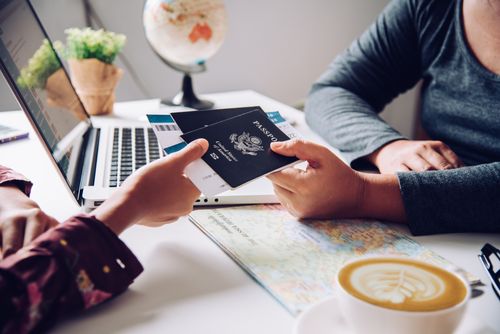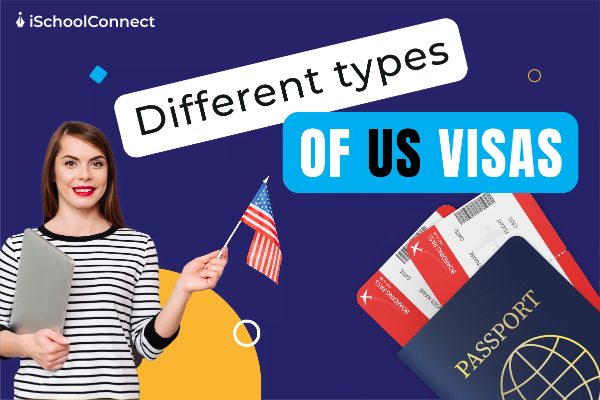Table of Contents
The United States is one of the top choices for studying abroad. Since it is home to several prestigious colleges and universities, the country has become a dream destination for students worldwide. Whichever course you want to pursue or the career field you wish to embark on, you’ll find something to meet your needs. So, if you have chosen to go for higher education in the US, you need to find out all about visa requirements. Here is everything you must know about types of US visas and application requirements.
Types of US visas
Majorly, the US visas can be divided into the following two categories-
- Non-immigrant Visa: They are issued to visitors who aren’t visiting the country to become permanent residents. Everyone from tourists and students to those visiting for business or medical purposes is given this visa. Typically, the application process for non-immigrant visas is significantly faster and easier.
- Immigrant Visa: They are for those looking to become the United State’s permanent residents. Obtaining these visas can take plenty of time. Those applying for this visa are required to file a petition with the US Citizenship and Immigration Services (USCIS), which a potential employer or a relative must sign. The top two types of US visas in this category are-
- Employment-based immigration visa
- Family-based immigration visa

US visas for students
There are three types of US visas for international students planning to study in this country. These are the following-
1. F1 Student Visa
The F1 student visa is issued for those visiting the United States to pursue higher education. Students applying for a course that requires over 18 hours of study every week are eligible for this visa. Additionally, students applying for all undergraduate programs or certain graduate programs like MBA and MS can obtain this visa. Once a higher education institute in the US grants them admission, students are provided with an I-20 document, making them eligible to apply for the F1 student visa. They must apply for the visa within 120 days of the I-20 start date. Also, they must travel within 30 days of the start date of the I-20.
2. M-1 Vocational/Non-Academic student visa
Another type of US visa for students is the M-1 vocational/non-academic student visa. But, only those applying to technical and vocational institutions can obtain an M-1 visa. The application procedure for the M-1 visa is the same as that for the F1 visa. However, the former is time-stamped upon the student’s entry, and no student is allowed to overstay their visit.
3. J-1 Exchange Visitor Visa
Many students enrolled in short-term study abroad programs travel to the US on a J-1 visa. This is another one of the types of US visas issued to students, lecturers, or visiting scholars pursuing an exchange program. It is typically sought by a working professional looking to visit the country on an exchange program. These exchange programs can include research fellowships and 10-month vocational training, among other things. However, only those for whom an approved sponsor in the US has accepted can apply for this visa. Also, the participants can only apply after receiving the DS-2019 form from their sponsor.

Types of US visas for dependents
The applicants’ spouses and children under 21 years of age can accompany them to the US by obtaining a separate visa. Here are the different types of US visas required by the dependents to enter the country.
1. F2 Student Dependent Visa
This non-immigrant dependent visa lets family members of those holding the F1 student visa visit the US. The student’s spouse and unmarried children under 21 years of age are eligible to apply for this visa. A student’s spouse on F2 status isn’t allowed to pursue a full-time course of study but can enroll in vocational or recreational classes like tennis or cooking. On the other hand, children on F2 status can become full-time students at a high, middle, or elementary school. However, they are not allowed to pursue a full-time course at a university or a college. Also, the children and spouses in F2 status cannot accept employment during their stay.
2. M2 Visa
Similar to the F2 student-dependent visa, the M-2 non-immigrant visa lets the spouse and children (under 21 years of age) of a valid M-1 student visa holder enter the United States. The terms and conditions of the dependents’ stay are also similar to those on F2 status.
3. J-2 Visa
Issued by the US Citizenship and Immigration Service (USCIS), the J-2 visa is a special visa for the spouses and children of J-1 Exchange Visitor Visa holders. Those who successfully obtain this visa can join a J1 visa holder in the US. However, the spouses on J2 status are allowed to work only when permission is obtained in advance.
Necessary documents for F1 student visa application
To obtain one of the types of US visas applicable for students, you must submit several documents. You will need to provide various mandatory documents, including supporting financial and academic documents. So, here are some of the necessary documents required for the F1 student visa application-
- A passport that remains valid for six months or more beyond your duration of stay.
- A printed copy of the online application form DS-160.
- Interview appointment letter (copy and original).
- Form I-20 sent by your college in the US.
- SEVIS fee receipt
- Visa fees payment confirmation receipt.
- Original marksheets or provisional certificates.
- Score sheet of English language proficiency tests like TOEFL, IELTS, and GMAT.

While applying for the F1 student visa, you will also need to submit certain documents to provide evidence of financial resources. These documents include-
- Tax returns for the previous 3 years (Form 16).
- Original pay/salary slips
- Letters of employment
- Bank statements/passbook for the previous 3 years.
- Scholarship letter (If you have availed a scholarship)
- Statement from a certified CA.
- Loan approval letter
In a Nutshell
There are multiple types of US visas for students looking to pursue higher education in the United States. Once you are sure of the correct visa type you will need, carry out the application process promptly to ensure a hassle-free start to your academic journey. In order to ensure a smooth and successful application process, make sure you gather all the necessary documents beforehand. Also, if you are planning to take your spouse or children along, make sure they acquire their dependent visa on time. In case of assistance for your US visa, reach out to us for a hassle-free visa application process.
Liked this Blog? Read more- 5 steps on how to get a student visa for USA | Complete guide
FAQs
Q1. Which are the top universities in the US should I apply to?
Some of the most popular universities in the US amongst international students include-
- Massachusetts Institute of Technology
- Harvard University
- Stanford University
- The University of Chicago
- Yale University
- University of Pennsylvania
- Columbia University
- California Institute of Technology
- Cornell University
- Princeton University
Q2. What is the acceptance rate for a US study visa?
Compared to other countries, the acceptance rate for a US study visa is relatively lower at only 85%. This makes it a little difficult for students to obtain a US visa. Moreover, authorities have been known to decline US visa applications on various grounds, such as incomplete documents, poor US student visa interview performance, and invalid proof of financial resources.
Q3. Will I be allowed to work in the US on a student visa?
Yes, international students can work in the US with a student visa. However, there are certain restrictions. Those on F-1 and M-1 status can work on campus or in specific training programs. Also, they cannot work off-campus during their first academic year.






